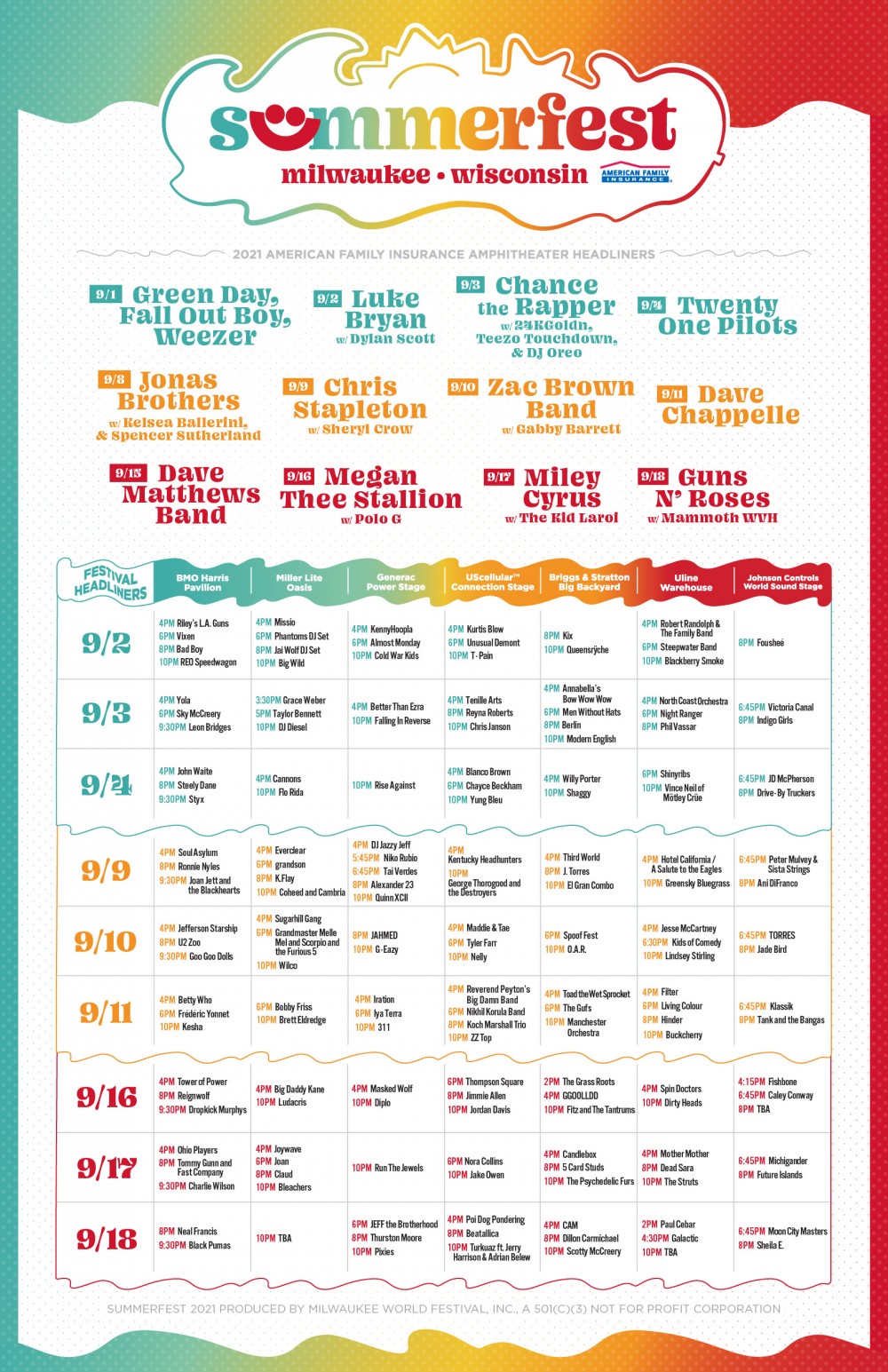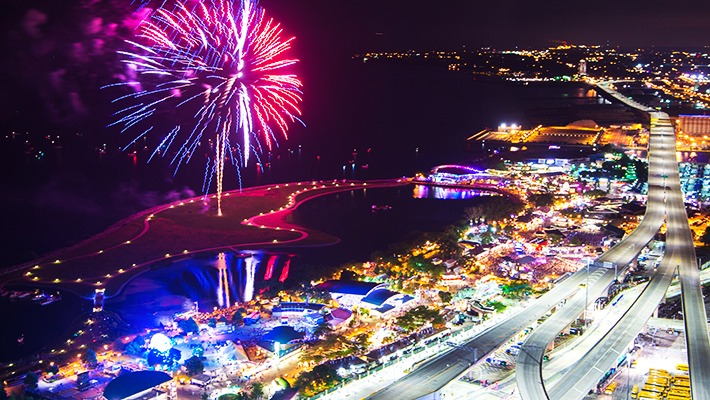As a kid growing up in Milwaukee, I looked forward to Summerfest with a holiday-like anticipation; as a teen, I grew to mock its supreme un-hipness, even as I still occasionally attended; as an adult living through a time in which music festivals happen on more summer weekends than not, I can only now appreciate quite how unusual my hometown’s version actually is. Summerfest isn’t necessarily better than your Lollapaloozas, Coachellas, or Newport Folks, but it is undeniably broader than those or any other big-name fest. It’s been running so long without a particular musical niche that it’s fallen into that rarest of zones: It’s an all-things-to-all-people gathering. If you can’t find something to like among roughly a thousand bands over ten days, well, you can still go eat some bratwurst, stare wistfully at Lake Michigan, or watch a juggler do his thing.
It’s easier not to be niche-bound when you’re the “World’s Largest Music Festival,” a title that Summerfest could rightfully claim for decades, based on attendance — which peaked in 2001 with just over a million people cumulatively through its gates. That’s quite a few more souls than live in the city of Milwaukee, to give it some perspective. It’s a yearly tourism boon, pushing $186 million into the local economy per annum, according to president and CEO Don Smiley. It’s the single biggest attraction the city can claim as its own — and it does so, loudly and proudly: You can see the smiley Summerfest logo all around town, all year round.
You also can’t miss Summerfest’s highly unusual site: The Henry Maier Festival Park spans 75 acres of absolutely prime real estate, right on Lake Michigan and directly adjacent to downtown Milwaukee. In the 1920s, the strip of land was an airport, and during the Cold War it was a military installation that housed nuclear-capable Nike missiles. Summerfest, which launched in 1968 at various venues around the city, took over the park — a generous word for it at that point, considering there wasn’t much there — in 1970, and slowly but surely built something permanent, both literally and figuratively.
In addition to Summerfest, the Maier Festival Park is also home to Milwaukee’s yearly ethnic festivals, which are generally much smaller affairs but nonetheless charming and fun: German Fest, Festa Italiana, Polish Fest, and others keep the park busy for a few extra summer days in normal years. Weirdly, the park is otherwise locked up tight the rest of the year, visibly lonely from the freeway that runs just above it, its stages and Skyglider quiet and still.
When I started going in the early 1980s, Summerfest still felt a little ramshackle, with only a few permanent structures on the grounds. The stages were typical of what you still see at most fests, erected and removed as needed. They were (and still are) strategically placed throughout the festival so that acts weren’t in sonic competition: If you were busy listening to Weird Al, you wouldn’t necessarily be disturbed by Greg Kihn or REO Speedwagon.

One ridiculously cheap ticket — under $10 per day at the time, still a crazy bargain at $23 — got you general admission access to every stage. Much of the schedule during the daytime back then was taken up by local bands playing to empty bleachers, but the nighttime programming was radically diverse, even then. Looking at the mid-’80s, I’m seeing R.E.M., Huey Lewis, Los Lobos, the Pointer Sisters, Bon Jovi, Eric Clapton, Kool & The Gang. The Replacements and Fishbone had day-ending slots in ‘91, as did Kansas. In 1989, I camped out overnight at the Summerfest box office for tickets to perhaps the coolest triple bill of all time — New Order, Public Image Ltd., and the Sugarcubes — and wound up in the front row.
Then as now, the vibe at Summerfest can be as tough to pin down as the music programming, and while it’d be slightly unfair to compare it to a more urban state fair, that’s also partly true. There’s very little of Coachella’s see-and-be-seen energy, perhaps because the families excited to see Michael “mouth noises guy from the Police Academy movies” Winslow don’t really give a shit about the neon mesh bodysuit-clad Foushee fans or the old metal dudes there for the latest iteration of L.A. Guns. It’s democracy in action, with space for a massive swath of popular and semi-popular music. Smiley tells me that’s all by design: “We purposely construct it for everyone.” He’s equally proud of booking international touring acts like Guns N Roses and Megan Thee Stallion as he is of the brand new Children’s Community Park, which includes sensory rooms, nursing rooms, and playground equipment.
As years passed and Summerfest grew, the park that contains it became more like a small city of its own. In 1987, they added a 23,000-seat amphitheater to draw even bigger bands — though tickets for those shows cost extra. Just last year — when Summerfest was canceled, rescheduled, then canceled and rescheduled again due to COVID — they completely rebuilt that amphitheater to better accommodate the kind of massive stage shows that have become the norm in more recent years. Other permanent stages, food service buildings, and offices are now in use, including the new-ish 10,000-capacity, separately ticketed BMO Harris Pavilion. All of the stages have delightfully corporate names, naturally, and Smiley proudly notes that Summerfest — which is a 501(c)(3) non-profit — has lots of corporate sponsors but much lower ticket prices, a fact that Milwaukeeans find a perfectly acceptable trade-off.
Which brings us to the uncertainty of 2021. With the early part of the year still so COVD-uncertain, Summerfest moved away from its usual June-into-July dates and will now take place over the first three weekends in September. The artists are, as usual, all over the map in the best ways: Green Day, Chance the Rapper, Chris Stapleton, Run the Jewels, Dave Chappelle, Miley Cyrus, Diplo, Pixies, 311. Thurston Moore is on the schedule right there next to the Steve Meisner Polka Band. At one end of the grounds you can see a David Bowie tribute band, and the other a ventriloquist act called Red Hot Chili Puppets that, sadly, has nothing to do with the band (beyond the name, anyway). As of this writing, the reserved seats for REO Speedwagon are sold out, but plenty remain for Joan Jett.
The delightful whiplash goes on and on, and it’s a big part of the Summerfest draw. The whole thing is unpretentious in the same way its home city is: People are there for a good time, and whether that involves waiting all day to be up in front for Coheed & Cambria or happening upon a juggling demonstration while munching on some ribs doesn’t much matter.

